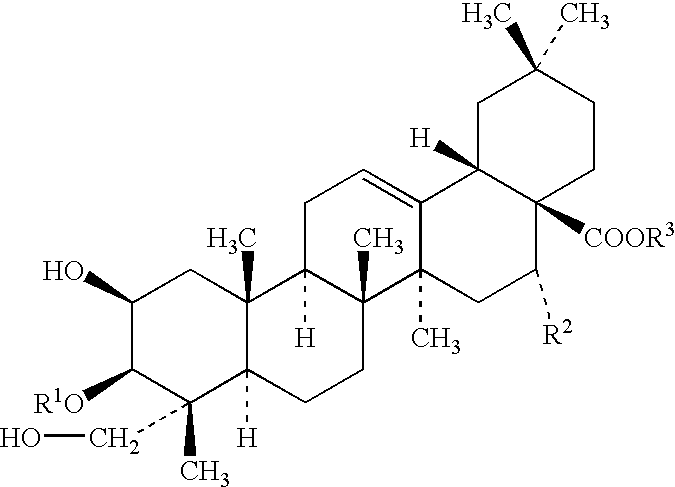Cosmetic and/or pharmaceutical preparations that contain an extract of the plant argania spinosa
a technology of argania spinosa and extract, which is applied in the field of cosmetics and/or pharmaceutical preparations, can solve the problems of skin irritation, hair damage, and film becoming very brittle,
- Summary
- Abstract
- Description
- Claims
- Application Information
AI Technical Summary
Benefits of technology
Problems solved by technology
Method used
Image
Examples
example 1
Extraction of the Plant Seeds
[0151] 0.2 kg of defatted Argania spinosa seeds were transferred to a glass vessel and covered with 2 l of 80% strength by weight aqueous ethanol. This mixture was stirred at room temperature for two hours and the solids were separated off by means of filtration. The ethanol from the filtrate of the crude extract was removed under reduced pressure (15 to 20 torr). The remaining aqueous extract was extracted again with n-butanol. The butanol was likewise separated off under reduced pressure and the aqueous remainder was lyophilized. Based on the weight of the plant seeds, 0.5% by weight of saponins was obtained.
example 2
Sensory Activity on Different Types of Hair
[0152] The evaluation of the modification of sensory properties on human hair in the comparison of damaged (bleached or permanently waved hair) with undamaged (control hair) after treatment with extracts of the plant Argania spinosa was carried out on standardized hair tresses (15 cm in length and 3 g in weight). The standard and placebo used was an aqueous sodium lauryl sulfate solution (15% w / v). The samples of the plant extracts were incorporated into the sodium lauryl sulfate solution in a concentration of 1.5% by weight and tested. The treatment effects were investigated on three different types of hair:
[0153] a) control hair: the tresses were washed with an aqueous sodium lauryl sulfate solution (15% by weight).
[0154] b) bleached hair: the tresses were treated with a bleaching shampoo which comprises 6% of H.sub.2O.sub.2 and ammonia (clair clair from L'Oral) for 30 min and then washed with the aqueous sodium lauryl sulfate solution (1...
example 3
Lipolysis Activity on Human Adipocytes
[0161] Background: Lipolysis is the name for the endogenous degradation of fats which are present in the adipocytes (fat cells) as reserves. These are cleaved enzymatically by lipases to give smaller molecular fragments the fatty acids and glycerol. The free fatty acids are then used by the muscle cells to produce energy.
[0162] Method: The adipocytes were isolated from human subcutaneous tissue, as corresponds to the general technique in accordance with Rodbell. The extract as in
[0163] Example 1 or the comparison substances are dissolved in the reference medium and then brought into contact with the isolated adipocytes for 90 minutes at 37.degree. C. In each case one adipocyte preparations [sic] was analyzed. The percentage increase in released glycerol in the supernatant of the medium was determined by means of spectrophotometry in accordance with the method by Carpn et al. The reference administered was the medium without substance to be analy...
PUM
 Login to View More
Login to View More Abstract
Description
Claims
Application Information
 Login to View More
Login to View More - R&D
- Intellectual Property
- Life Sciences
- Materials
- Tech Scout
- Unparalleled Data Quality
- Higher Quality Content
- 60% Fewer Hallucinations
Browse by: Latest US Patents, China's latest patents, Technical Efficacy Thesaurus, Application Domain, Technology Topic, Popular Technical Reports.
© 2025 PatSnap. All rights reserved.Legal|Privacy policy|Modern Slavery Act Transparency Statement|Sitemap|About US| Contact US: help@patsnap.com

